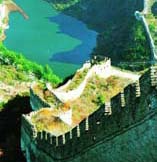 Badaling, Mutianyu, and Simatai usually come to mind when one thinks of the Great Wall. These sections have become hot tourist spots after being renovated. But Huanghuacheng, a section of the Great Wall about 60 kilometers north of the city proper of Beijing, is still little known.
Badaling, Mutianyu, and Simatai usually come to mind when one thinks of the Great Wall. These sections have become hot tourist spots after being renovated. But Huanghuacheng, a section of the Great Wall about 60 kilometers north of the city proper of Beijing, is still little known.
Although not as magnificent as Badaling or as precipitous as Simatai, Huanghuacheng stands as it used to. It is said that rice water was used as an adhesive to fix the bricks together, making the wall at this section extremely solid. Although it is largely damaged today, people can still find watchtowers, passes, and battlements, some of which remain intact. A huge rock stands out at one of the passes and is carved with two characters, (Jin Tang), hence this section is also called the Jin Tang Great Wall.
Huanghuacheng, historically known as Huanghuazhen, used to be a famous military fortress that stretched over 10,000 meters. Distinctive from other sections of the Great Wall, Huanghuacheng is separated by a several-dozen-meter-deep lake, around which green grass flourishes, and in which various fish shuttle. Springs abound in nearby villages, and because of this a majority of the local households have their own fishponds. Brown trout raised in spring water is a delicacy of the area. It can be eaten raw; or it can be steamed. The fish though is most delicious when roasted. Brown trout has very few bones, and the soup made of its head is aromatic and stimulates people's appetite.
From April to November, Huanghuacheng is at its best. In summer, explorers can find a place at one of the battlements and sleep in the open.
The first time I visited Huanghuacheng, I got acquainted with an American girl who was studying in Beijing at the time. I was surprised to learn that she spent one or two weekends a month at Huanghuacheng. She loved the primitive simplicity of this place and enjoyed relaxing on top of the mountain. "Every time I come here I experience a different feeling," she said, "I will never tire of the landscapes here." Huanghuacheng was the only thing that impelled her to stay longer in Beijing.
I go to Huanghuacheng every April and October. In April, I climb the Great Wall and taste brown trout. April is the season for edible wild herbs, and hospitable local farmers are ready to serve tourists palate-pleasing dishes cooked with the wild herbs.
In October, I like to view the beautiful autumn scene of Beijing from the top of the Great Wall: a couple of white clouds drift slightly in the azure sky, while green, red, and yellow leaves color the ground. Autumn is also the harvesting season for fruit. The chestnuts grown here are big and tasty and sell well in the international market. Pear trees on the mountainside bear rich fruit. Jujube trees are planted in every household's courtyard; and the fruit is larger, crisper, and sweeter than those found in urban markets. Huanghuacheng has also triggered a childhood memory: whenever I had a newly born walnut, I liked taking out the thin white peel of the kernel and eating the fresh pulp, which was very tasty. I believe that these are some of the major reasons why my American friend became a frequent visitor of this place.
By winter, Huanghuacheng is exceedingly chilly. But when snow falls, the scenery is amazing.
Huanghuacheng provides a challenge as it has no stone steps or no single smooth path like the ones found at Badaling and other sections of the Great Wall. In the summer, in particular, when the wild grass and shrubs grow as tall as people it's very easy to get lost. Sometimes, I have had to use my hands to climb, and very often my clothes have been torn before I've even noticed.
Battlements rise one higher than another; and you have to be courageous if you want to reach the summit. Once you breathe the pure and fresh air and see the stunning natural scenery from the summit though you feel completely relieved and forget everything that once worried you.
Transportations:Take Bus 916 or 936 at Dongzhimen bus station to Huairou County first, then turn bus 916 at the Huairou bus station to Huanghuacheng.
(China Pictorial December 18, 2002)
|

